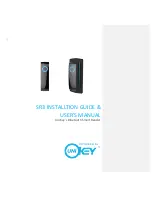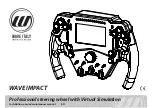
Manual Fiber Polarization Controllers
Chapter 2: General Description
Page 2
1167-D02
Chapter 2 General Description
These manual polarization controllers utilize stress-induced birefringence to
alter the polarization in single mode fiber that is looped around two or three
independent spools to create two or three independent fractional wave plates
(fiber retarders). The amount of birefringence induced in the fiber is a function
of the fiber cladding diameter, the spool diameter (fixed), the number of fiber
loops per spool, and the wavelength of the light. (NOTE: The desired
birefringence is induced by the loop in the fiber, not by the twisting of the fiber
paddles). The fast axis of the fiber, which is in the plane of the spool, is
adjusted with respect to the transmitted polarization vector by manually
rotating the paddles to twist the fiber.
To transform an arbitrary input polarization state into an arbitrary output
polarization state, a combination of three paddles (a quarter-wave plate, a
half-wave plate, and a quarter-wave plate) or two paddles (quarter-wave plate
and a quarter-wave plate) is used. The retardance of each paddle may be
estimated from the following equation:
2
Here,
φ
is the retardance,
a
is a constant (0.133 for silica fiber),
N
is the
number of loops,
d
is the fiber cladding diameter,
λ
is the wavelength, and
D
is the loop diameter. While this equation is for bare fiber, the solution for Ø900
µm jacketed fiber will be similar enough that the results for this equation can
still be used (i.e., the solution will not vary by a complete loop
N
for Ø900 µm
jacketed fiber).
The FPC020, FPC030, and FPC560 are empty controllers in which the user
can install a fiber of their choice. The rest of our fiber polarization controllers
have fiber pre-installed to optimize the polarization control at common
wavelengths. These controllers can also be customized using the information
provided in Sections 2.1 through 0.





































